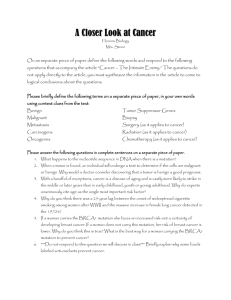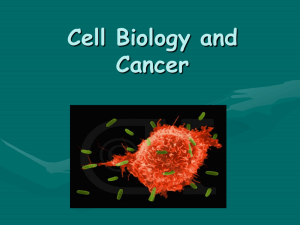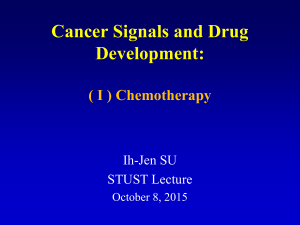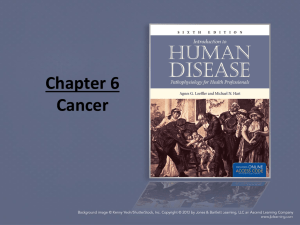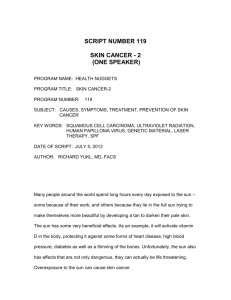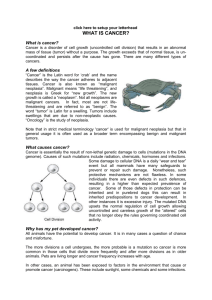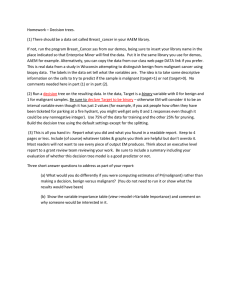Cancer Pathology and Signal Mechanisms Kung-Chao Chang ( Associate Professor
advertisement
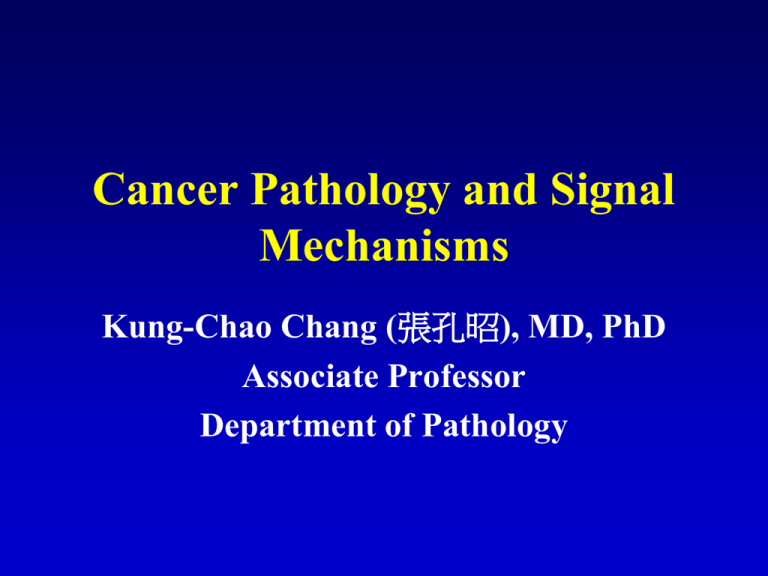
Cancer Pathology and Signal Mechanisms Kung-Chao Chang (張孔昭), MD, PhD Associate Professor Department of Pathology Programs (A) Definitions of tumors, benign and malignant. (B) Carcinogens: chemicals, virus, hereditary, and inflammation (C) Mechanism of carcinogenesis (D) Kinetics of tumor growth (E) Cancer invasion and metastasis (F) Therapy for cancers : conventional vs. target therapy 九十五年臺灣地區主要死亡原因 順位 死亡原因 所有死亡原因 1 2 3 4 5 6 7 8 9 10 惡性腫瘤 腦血管疾病 心臟疾病 糖尿病 事故傷害 肺炎 慢性肝病/肝硬化 腎臟疾病 自殺 高血壓性疾病 *每十萬人口 死亡人數 死亡率* 135,071 591.8 37,998 12,596 12,283 9,690 8,011 5,396 5,049 4,712 4,406 1,816 166.5 55.2 53.8 42.5 35.1 23.6 22.1 20.6 19.3 8.0 % 100.00 28.1 9.3 9.1 7.2 5.9 4.0 3.7 3.5 3.3 1.3 NEOPLASIA • New growth • “an abnormal mass of tissue, the growth of which exceeds and is uncoordinated with that of the normal tissues and persists in the same excessive manner after the cessation of the stimuli which evoked the change” Loss of Normal Growth Control NEOPLASIA Fundamental to the origin of all neoplasms is loss of responsiveness to normal growth control. 上皮癌症前期病灶變化 Benign tumor Malignant tumor CLASSIFICATION OF NEOPLASMS • Differentiation is a term referring to the degree to which a neoplasm resembles, in structure and function, its normal counterpart (cell of origin). – – – – well differentiation moderately differentiation poorly differentiation undifferentiation (anaplastic) Degree of Cellular Differentiation • Benign – more differentiated • Malignant – less differentiated Growth Rate of Neoplasm • Benign: slow • Malignant: fast Mode of Growth • Benign: capsule expansion with fibrous • Malignant: invasion and infiltration without capsule • Benign neoplasms do not metastasize • Malignant neoplasms do metastasize (or have the capacity to metastasize) 大腸癌病理分期 Mucosa Muscularis mucosae Submucosa Muscularis propria Subserosa Serosa Lymph node Stage I Stage II Stage III AJCC, 臨床分期 and Survival Different Kinds of Cancer Some common carcinomas: Lung Breast (women) Colon Bladder Prostate (men) Leukemias: Bloodstream Lymphomas: Lymph nodes Some common sarcomas: Fat Bone Muscle Classification of cancers by origin 1. Epithelial carcinoma 2. Mesenchymal sarcoma 3. Hematopoietic (blood cancer) lymphoma, leukemia Epithelia and derived carcinomas Cervix Skin Figure 2.6a-b The Biology of Cancer (© Garland Science 2007) Esophageal Ca. Squamous cell carcinoma (SCC) Epithelia and derived carcinomas Stomach Ca. Small intestine Ca. Figure 2.6c-d The Biology of Cancer (© Garland Science 2007) Lung carcinoma classification Table 2.2 The Biology of Cancer (© Garland Science 2007) Liposarcoma Osteosarcoma Figure 2.7a The Biology of Cancer (© Garland Science 2007) Pleomorphic rhabdomyosarcoma (ALL) (AML) (CML) (CLL) (MM) Table 2.3 The Biology of Cancer (© Garland Science 2007) Etiology of Cancers: Carcinogenic Agents • Chemical carcinogens: Direct-acting carcinogens Natural products:Betel nuts, aflatoxin, smoking • Radiation carcinogenesis: Ionizing radiation:chromosome breakage, translocation, mutation UV ray:pyrimidine dimer, leading to mutation • Viral and microbial carcinogens: DNA viruses RNA viruses Helicobacter pylori • Hereditary cancers: Xeroderma pigmentosa Retinoblastoma (Rb) Colon, breast, ---et al Betel nut-associated oral cancer Arsenic skin cancer in Southwestern Taiwan: Multiple at different stages High prevalence of several cancers in blackfoot disease areas Viral and Microbial Carcinogenesis •Oncogenic RNA viruses: HTLV-1 (human T-lymphotropic virus type I): adult T cell leukemia/lymphoma Tax protein as Oncoprotein HCV (hepatitis C virus):hepatoma, lymphoma •Oncogenic DNA viruses: HPV (human papilloma virus):cervical cancer HBV (hepatitis B virus):hepatoma EBV (Epstein-Barr virus):lymphoma, nasopharyngeal carcinoma •Helicobacter pyloric and gastric lymphoma •Inflammation (virus and bacteria)–associated cancers:Cytokine and NFkB activation HPV-associated papilloma and cancers: viral genotypes HPV 6/11 or 16/18 HPV disease progression HPV vaccination before 12 year of age Insertional mechanism of viral tumorigenesis HBV/HCV and hepatocellular carcinoma (HCC, hepatoma): HCV-core, HBx, pre-S mutants, regeneration Helicobacter pylori-associated mucosa-associated lymphoid tissue (MALT) type-lymphoma Extranodal Postgerminal Trisomy 18, Arises at marginal center t(11;18), extranodal zone memory t(1;14); latter sites in adults lymphoma B-cell create MALT1with chronic IAP2 and inflammatory BCL10-IgH diseases; may fusion genes, remain respectively localized; indolent Helicobacter pylori-associated mucosa-associated lymphoid tissue (MALT) type-lymphoma Scanning EM and Warthin-Starry stain of Helicobacter pylori (HP) Familial Adenomatous Polyposis (FAP) 家族性多發腸息肉症侯群 • 10-15歲以前腸道(大腸為主)發生多數目的 腸息肉. • 50歲以前這些腸息肉中會發生癌變. • 身體其它組織也可能有不正常的情形(例如視 網膜色素細胞先天性肥大 congenital hypertrophy of the retinal pigment epithelium 或 發生於胸、腹壁上的纖維瘤 desmoid). Familial polyposis and colon cancer: cancer develops at 20 years of age Genetic model for colorectal carcinogenesis Stepwise progression of Tumorigenesis Kinetics of tumorigenesis: Tumor development usually takes a long period, a balance between tumor cells and environment factors Essential Alterations for Malignant Transformation 1. self-sufficiency in growth signals: oncogenes 2. insensitivity to growth inhibitory signals: tumor suppressor genes 3. evasion of apoptosis 4. DNA repair defects and genomic instability in cancer cells 5. limitless replicative potential: telomerase 6. development of sustained angiogenesis 7. invasion and metastasis Principal Targets of Genetic Damage Oncogenes 致癌基因 Normal Cell Apoptosis genes 凋亡 Tumor suppressor genes 抑癌 DNA mismatch repair genes 錯誤配對修護 Cancer Cell Oncogenes (致癌基因), Oncoproteins • Growth factors: PDGF, FGF, TGF… • Growth factor receptors: EGFR, PDGFR • Signal-transducing proteins: RAS, RAF, βcatenin • Transcription factors: MYC • Cyclins and cyclin-dependent kinases Growth factors and signal-transducing proteins Insensitivity to Growth Inhibitory Signals: Tumor Suppressor Genes • Retinoblastoma as a Paradigm for the Two-Hit Hypothesis of Oncogenesis • p53: Guardian of the Genome • APC/b-Catenin Pathway • Others: – The INK4a/ARF locus, The TGF-b pathway, NF-1 gene, NF-2 gene, VHL, PTEN, WT-1, Cadherins, KLF6, PTCH. Retinoblastoma as a good model for hereditary carcinogenesis in young children Guardian of the Genome DNA Repair Defects and Genomic Instability in Cancer Cells • Hereditary Nonpolyposis Cancer Syndrome • Xeroderma Pigmentosum • Inherited Diseases with Defects in DNA Repair by Homologous Recombination – BRCA1 and BRCA-2 Genes XP is an autosomal recessive disease with sun sensitivity, photophobia, early onset of freckling, and subsequent neoplastic changes on sun-exposed surfaces DNA Repair Defects MSH2, MLH1 Breast Cancer 乳癌 • cluster in families, but extensive families with a clear inherited basis proved difficult to identify due to : 1. 男性很少。 2. 臨床上沒有像家族性腸息肉症侯群那樣直接可以辨 認。 3. 乳癌是常見的癌,因此除非有很明顯的家族史,否 則不易察出。 Metastatic routes of cancers: lymphatic and hematogenous Development of Sustained Angiogenesis (VEGF) Treatment of cancers • • • • Surgical removal (手術) Radiotherapy (電療) Chemotherapy (化療) Targeted therapy (標靶治療) Any question?

